OLDSMOBILE BRAVADA 1994 Owners Manual
Manufacturer: OLDSMOBILE, Model Year: 1994, Model line: BRAVADA, Model: OLDSMOBILE BRAVADA 1994Pages: 248, PDF Size: 14.54 MB
Page 161 of 248

4. Use the wheel wrench to remove the
wheel nuts that secure the tire to the
carrier. Then lift the tire
off the
mounting bracket.
For Both Mounting Systems:
5. Put the spare tire near the flat one.
6. Using the Torx@ head wrench
supplied with the vehicle and stored
in the glove
box, remove the wheel
nut cover.
7. Using the wheel wrench, loosen all tht
wheel nuts. Don’t remove them yet.
155
ProCarManuals.com
Page 162 of 248
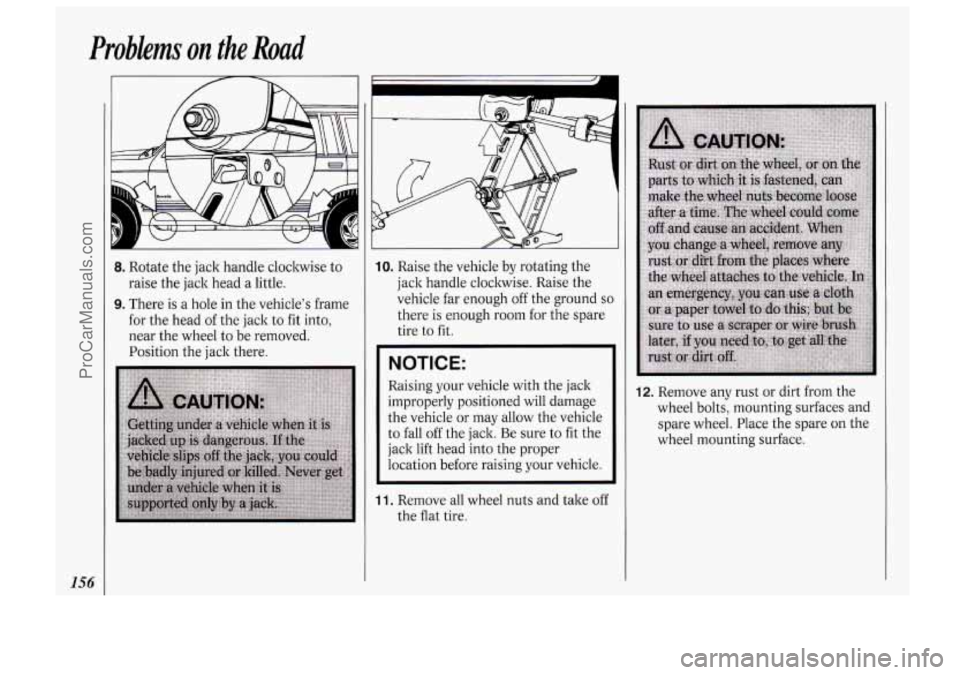
Problems on the Road
156
8. Rotate the jack handle cloclwise to
raise the jack head
a little.
9. There is a hole in the vehicle’s frame
for the head of the jack to fit into,
near the wheel to be removed.
Position the jack there.
10. Raise the vehicle by rotating the
jack handle cloclwise. Raise the
vehicle far enough off the ground
so
there is enough room for the spare
tire to fit.
NOTICE:
Raising your vehicle with the jack
improperly positioned will damage
the vehicle or may allow the vehicle
to fall off the jack. Be sure to fit the
jack
lift head into the proper
location before raising your vehicle.
11. Remove all wheel nuts and take off
the flat tire.
12. Remove any rust or dirt from the
wheel bolts, mounting surfaces and
spare wheel. Place the spare on the
wheel mounting surface.
ProCarManuals.com
Page 163 of 248
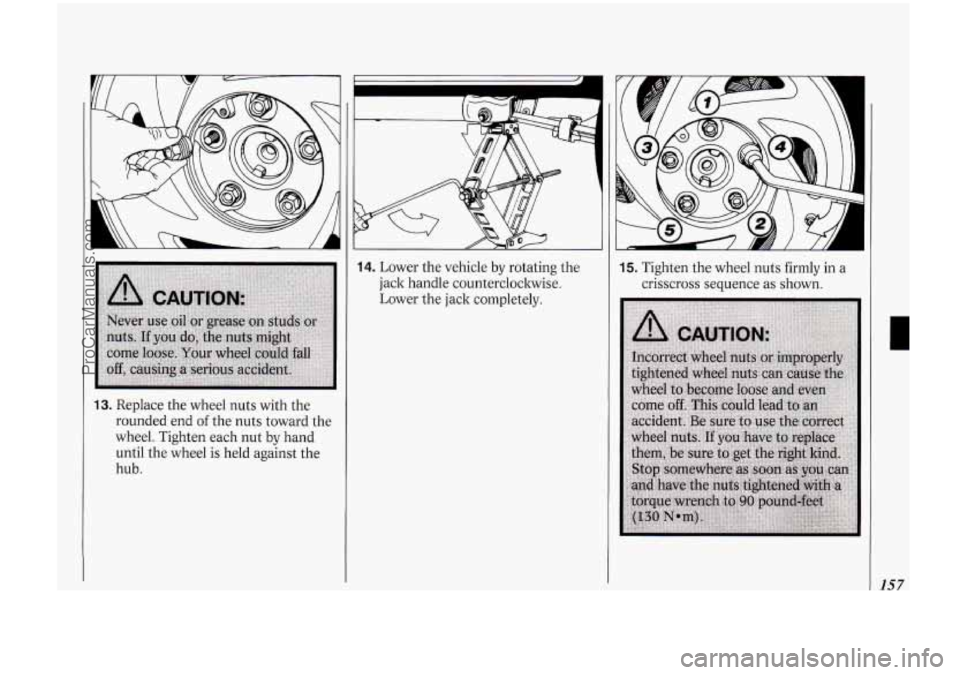
13. Replace the wheel nuts with the
rounded end
of the nuts toward the
wheel. Tighten each nut by hand
until the wheel is held against the
hub.
14. Lower the vehicle by rotating the
jack handle countercloclnvise.
Lower the jack completely. 15. Tighten the wheel nuts firmly in a
crisscross sequence as shown.
157
ProCarManuals.com
Page 164 of 248

Problems on the Road
158
I
16. Replace the wheel nut cover on the
spare wheel. Be sure to insert the
pin on the wheel cover into the hole
in the wheel. Screw the cover in
place using the TorxB head wrench.
17. Lower the jack head completely by
rotating the jack handle
counterclockwise. If you have an
inside-mounted spare tire, return
the jack and wheel wrench to their
storage compartment and secure
them with the wing nut. Replace the
jack storage compartment cover.
18. Fasten the flat tire where the spare
was stored. If you have a tailgate-
mounted spare tire carrier, tighten
firmly. Push and pull to make sure it
is not loose.
As soon as possible,
tighten the nuts to 22-32 pound-feet
(30-40
Nom) torque.
I If You’re Stuck: In Sand,
Mud, Ice or Snow
19. If you have a tailgate-mounted spare
tire, return the jack and wheel
wrench to their storage
compartment and replace the jack
storage compartment cover. Insert
the cover tabs into the trim panel,
align the cover and fasten the latch. What
you
don’t want to do when your
vehicle is stuck is to spin your wheels.
The method known as “rocking” can
help you get out when you’re stuck, but
you must use caution.
ProCarManuals.com
Page 165 of 248
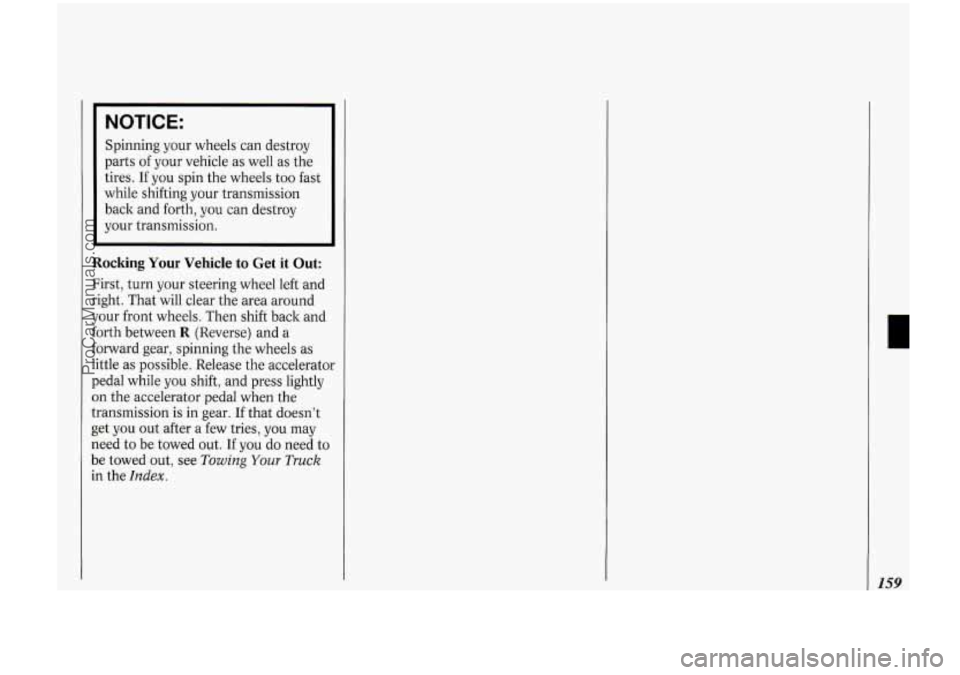
NOTICE:
Spinning your wheels can destroy
parts
of your vehicle as well as the
tires.
If you spin the wheels too fast
while shifting your transmission
back and forth, you can destroy
your transmission.
Rocking Your Vehicle to Get it Out:
First, turn your steering wheel left and
right. That will clear the area around
your front wheels. Then shift back and
forth between
R (Reverse) and a
forward gear, spinning the wheels as
little as possible. Release the accelerator
pedal while you shift, and press lightly
on the accelerator pedal when the
transmission
is in gear. If that doesn’t
get you out after a few tries, you may
need
to be towed out. If you do need to
be towed out, see
Towing Your Truck
in the Index.
159
ProCarManuals.com
Page 166 of 248
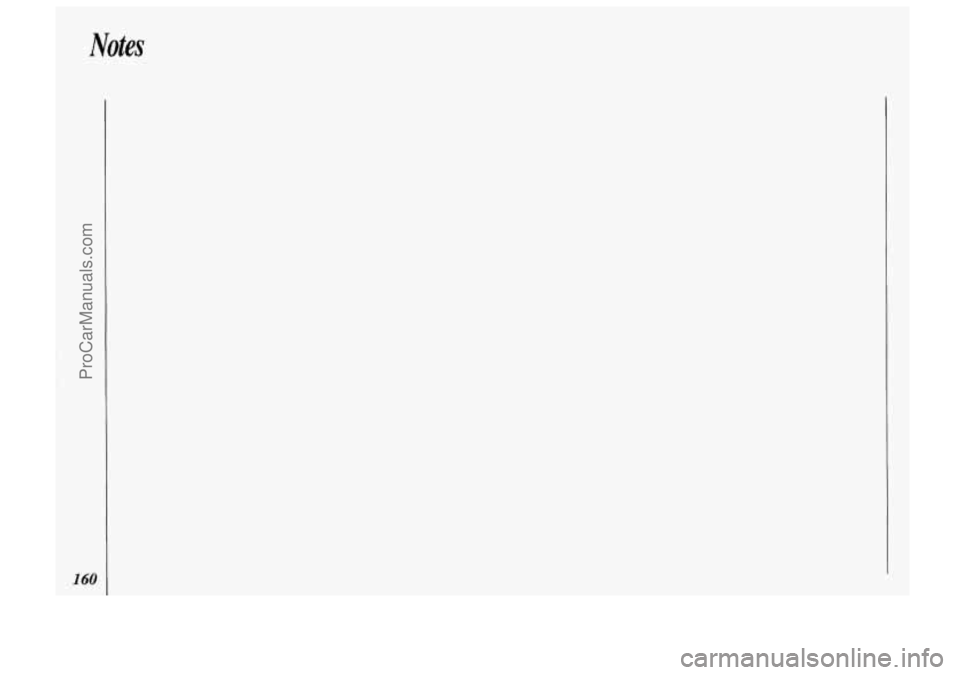
Notes
160
ProCarManuals.com
Page 167 of 248

Part 6
Sewice &Appearance Care
Service ........................................................................\
............................................. 162
Fuel
........................................................................\
.................................................. 163
Hood Release
........................................................................\
................................... 165
Engine Oil
........................................................................\
........................................ 168
Air Cleaner
........................................................................\
...................................... 171
Transmission Fluid ........................................................................\
.......................... 172
Axles/Transfer Case
........................................................................\
........................ 174
Engine Coolant
........................................................................\
................................ 174
Power Steering Fluid
........................................................................\
....................... 176
Windshield Washer Fluid ........................................................................\
................
177
Brakes ........................................................................\
.............................................. 178
Battery ........................................................................\
............................................. 180
Bulb Replacement
........................................................................\
........................... 181
Windshield Wiper Blade Replacement ................................................................... 182
..
Loading Your Vehicle ........................................................................\
..................... 183
Tires ........................................................................\
................................................. 185
Appearance Care ........................................................................\
............................. 190
Vehicle Identification Number (VIN)
.................................................................... 195
Add-on Electrical Equipment
........................................................................\
........ 196
Fuses
& Circuit Breakers ........................................................................\
................ 196
Capacities
& Specifications ........................................................................\
............ 199
Normal Maintenance Replacement Parts
............................................................... 200
Fluids & Lubricants ........................................................................\
........................ 201
Replacement Bulbs
........................................................................\
.......................... 202
.
161
ProCarManuals.com
Page 168 of 248
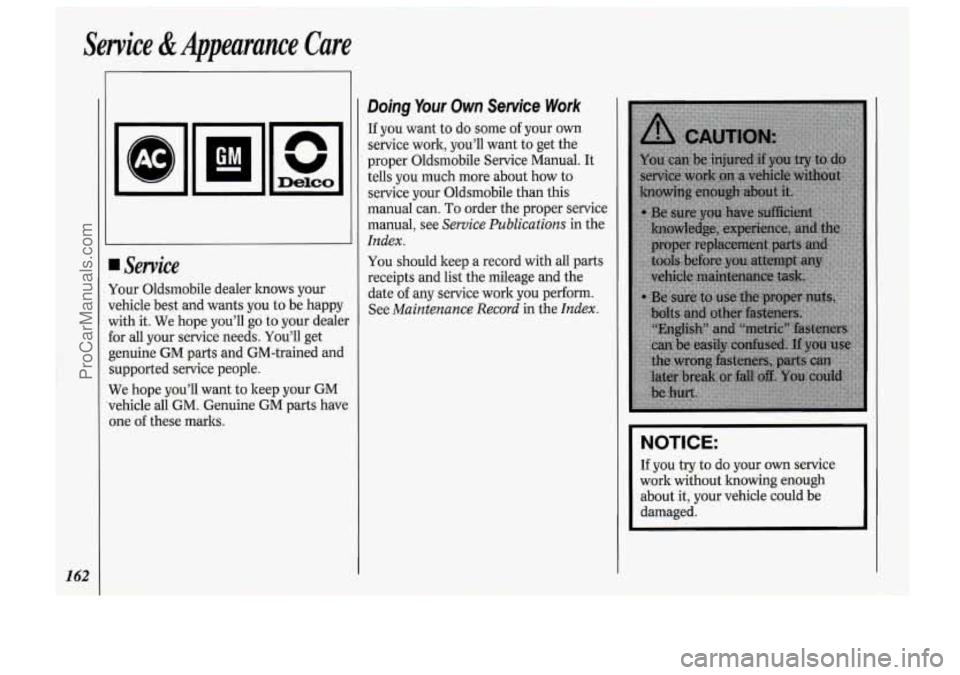
Sewice & Appearance Care
162
GM -
Service
Your Oldsmobile dealer knows your
vehicle best and wants you to be happy
with it. We hope you’ll go to your dealer
for all your service needs. You’ll get
genuine GM parts and GM-trained and
supported service people.
We hope you’ll want to keep your GM
vehicle all GM. Genuine GM parts have
one
of these marks.
Doing Your Own Service Work
If you want to do some of your own
service work, you’ll want to get the
proper Oldsmobile Service Manual. It
tells you much more about how to
service your Oldsmobile than this
manual can.
To order the proper service
manual, see
Service Publications in the
Index.
You should keep a record with all parts
receipts and list the mileage and the
date
of any service work you perform.
See
Maintenance Record in the Index.
NOTICE:
If you try to do your own service
work without knowing enough
about it, your vehicle could be
damaged.
ProCarManuals.com
Page 169 of 248

Fuel
Use regular unleaded gasoline rated at
87 octane or higher. Use premium
unleaded gasoline rated at 91 octane or
higher for high power performance,
when towing a trailer or with a high
payload requirement. But when
operating with a light load as
a normal
condition, you may use middle grade or
regular unleaded gasolines.
The gasoline you use should meet
specifications ASTM D4814 in the U.S.
and CGSB
3.5-92 in Canada. These
fuels should have the proper additives,
so you should not have to add anything
to the fuel.
In the
U.S. and Canada, it’s easy to be
sure you get the right kind of gasoline
(unleaded). You’ll see “UNLEADED” right
on the pump. And only unleaded
nozzles will fit into your vehicle’s filler
neck.
Be sure the posted octane is at least 91
for premium, 89 for middle grade and
87 for regular.
If the octane is less than
87, you may get a heavy knocking noise
when you drive. If it’s bad enough, it
can damage your engine.
If you’re using fuel rated at 91 octane or
higher and you still hear heavy
knocking, your engine needs service.
But don’t worry
if you hear a little
pinging noise when you’re accelerating
or driving up a hill. That’s normal, and
you don’t have to buy a higher octane
fuel to get rid of it. It’s the heavy,
constant knock that means you have a
problem.
What about gasoline with blending
materials that contain oxygen
(oxygenates), such as MTBE or
alcohol?
MTBE is “methyl tertiary-butyl ether.”
Fuel that
is no more than 15% MTBE is
fine for your vehicle.
Ethanol is ethyl or grain alcohol.
Properly-blended fuel that is no more than
10% ethanol is
fine for your
vehicle.
Methanol is methyl or wood alcohol.
NOTICE:
Fuel that is more than 5%
methanol is bad for your vehicle.
Don’t use it. It can corrode metal
parts in your fuel system and also
damage plastic and rubber parts.
That damage wouldn’t be covered
under your warranty. And even at
5% or less, there must be
“cosolvents” and corrosion
preventers in this fuel to help avoid
these problems.
GasoUnes for Cleaner Air
Your use of gasoline with deposit
control additives will help prevent
deposits from forming in your engine
and fuel system. That helps keep your
engine in tune and your emission
control system working properly. It’s
good for your vehicle, and you’ll be
doing your part for cleaner air.
Many gasolines are now blended with
oxygenates. General Motors
163
ProCarManuals.com
Page 170 of 248

Sewice & Appearance Care
I
164
recommends that you use gasolines
with these blending materials, such as
MTBE and ethanol. By doing
so, you
can help clean the air, especially in
those parts of the country that have
high carbon monoxide levels.
In addition, some gasoline suppliers are
now producing reformulated gasolines.
These gasolines are specially designed
to reduce vehicle emissions. General
Motors recommends that you use
reformulated gasoline. By doing
so, you
can help clean the air, especially in
those parts of the country that have
high ozone levels.
You should ask your service station
operators if their gasolines contain
deposit control additives and
oxygenates, and if they have been
reformulated to reduce vehicle
emissions.
Fuels in Forei’ Countries
If you plan on driving in another
country outside the
U.S. or Canada,
unleaded fuel may be hard to find.
Do
not use leaded gasoline. If you use even
one tankful, your emission controls
won’t work well or at all. With
continuous use, spark plugs can get
fouled, the exhaust system can corrode,
and your engine oil can deteriorate
quickly. Your vehicle’s oxygen sensor
will be damaged. All of that means
costly repairs that wouldn’t be covered
by your warranty.
To check on fuel availability, ask an
auto club, or contact a major oil
company that does business in the
country where you’ll be driving.
You can
also write us at the following
address for advice. Just tell us where
you’re going and give your Vehicle
Identification Number (VIN)
.
General Motors Overseas Distribution
North American Export Sales (NAES)
1908 Colonel Sam Drive
Oshawa, Ontario
L1H 8P7
Corporation
ProCarManuals.com